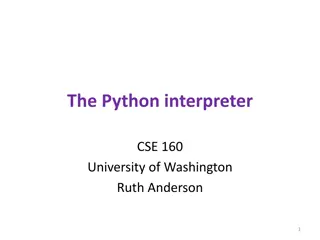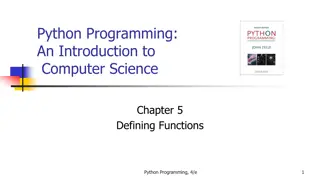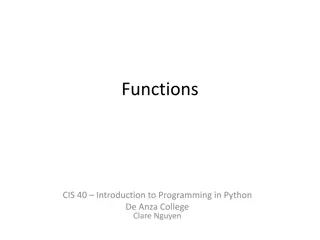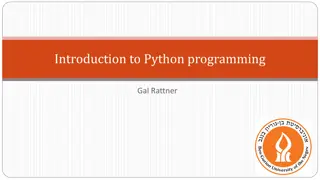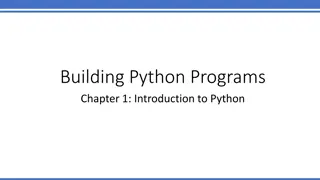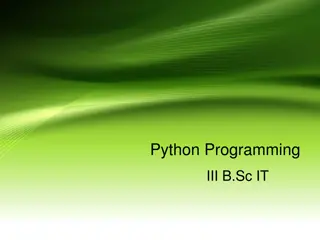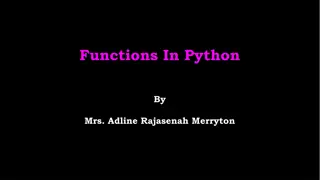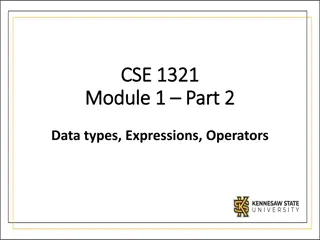Understanding Functions in Python Programming
Functions in Python are named sequences of statements that perform actions, accept parameters, and may return values. Modular programming involves breaking down complex problems into smaller pieces, making code easier to manage, read, and reuse. Using modules allows organizing related functions in one file for easy access. Learn about the importance of functions, modular programming, and how to structure and call functions in Python.
Download Presentation

Please find below an Image/Link to download the presentation.
The content on the website is provided AS IS for your information and personal use only. It may not be sold, licensed, or shared on other websites without obtaining consent from the author. Download presentation by click this link. If you encounter any issues during the download, it is possible that the publisher has removed the file from their server.
E N D
Presentation Transcript
Lecture 3 Functions Bryan Burlingame 13 February 2019
Announcements Labs are due at the start of lab Read chapters 4 & 5 Homework 1 due up front Homework 2 due next week
Learning Objectives Explain the concept of modular program design Explain the concept of a function in Python Explain why functions are important in programming Demonstrate the structure of a simple function
Modular Programming Break a large problem into smaller pieces Smaller pieces sometimes called subroutines , procedures or functions Why? Helps manage complexity Smaller blocks of code Easier to read Encourages re-use of code Within a particular program or across different programs Allows independent development of code Provides a layer of abstraction Hides the details of complex solutions Python has several built-in functions Decomposing complex problems into manageable subsets and then implementing those subsets as a set of functions is a key concept and skill
Modular Programming Break a large problem into smaller pieces Smaller pieces sometimes called subroutines , procedures or functions Why? Helps manage complexity Smaller blocks of code Easier to read Encourages re-use of code Within a particular program or across different programs Allows independent development of code Provides a layer of abstraction Hides the details of complex solutions Python has several built-in functions print( Hello world )
Functions Functions are named sequences of statements that perform some action Functions accept parameters in a parameter list and may return values Functions which do not return a value are called void functions A function call is the activation of a function a = 55.66 b = int(a) Variable storing a return value (b) Parameter (a) Function call (int)
Using Modules Modules are collections of related functions stored in one file Module Objects are the namespaces under which functions stored in a module are accessed A module is imported with the import keyword Functions within a module are accessed using dot notation (ex. math.sin(value))
Using Modules Module Objects Modules are collections of related functions stored in one file Module Objects are the namespaces under which functions stored in a module are accessed A module is imported with the import keyword Functions within a module are accessed using dot notation (ex. math.sin(value))
Side note: when is zero not zero? sine( ) = 0, right? Using Modules Modules are collections of related functions stored in one file Module Objects are the namespaces under which functions stored in a module are accessed A module is imported with the import keyword Functions within a module are accessed using dot notation (ex. math.sin(value))
Aliases Shortened names to refer to module objects Declared using the as keyword
Composition Using an expression as part of a larger statement Anywhere a value can be used, a function which returns a value can be used in its place In this example, a call to math.tan is a parameter for a call to math.cos which in turn is a parameter to math.sin, which is in turn a parameter to print. This works because tan returns a float, which is a valid parameter value for cos, which in turn returns a float, which is a valid parameter value for sin, etc.
Defining Simple Functions A function is defined with the def keyword Functions have two parts, a header and a body The header gives the function a name and defines allowed parameters The header is the first line The body contains the statements which define the functions action Note how the body is indented Together, the header and body is the function definition
Variable Scope Variables which are declared within a function or are in the parameter list can only be used within that function s is local to print_sum, it can be used here not here These variables are said to be local to that function Variables declared in the main function cannot be used in a function Note the error Where a variable is valid, is the scope of the variable
Variable Scope Variables which are declared within a function or are in the parameter list can only be used within that function These variables are said to be local to that function Variables declared in the main function cannot be used in a function Note the error Where a variable is valid, is the scope of the variable Parameters are copied in order
More Details print_hello definition Functions must be defined before they can be used print_hellohello definition Locally defined functions can be used within other locally defined functions main function definition The main function is the entry point to the program The main function has no header and is not indented The main function follows all function definitions
Stack Diagrams A diagram showing the functions of a program and the variables and values which exist within each function in the order they are called x -> 5 y -> 7 __main__ m -> 5 n -> 7 print_sum_twice a -> 5 b -> 7 s -> 12 print_sum
Stack Diagrams When there is a run-time error in Python, the interpreter will generate a Traceback This Traceback follows the same order as a stack diagram
Jupyter Markdown Markdown is a simple language for formatting text within a Jupyter notebook To use Markdown, the cell must be set to Markdown Various symbols change the way the text is displayed Symbol # ## > *** _ __ Function Location Creates a headline Creates a subheadline Indents for attribution (blockquote) Creates a horizontal rule Light Emphasis Strong Emphasis At beginning of line At the beginning of line At the beginning of paragraph Alone on a line Around a word _italics_ Around a word __bold__ https://sourceforge.net/p/jupiter/wiki/markdown_syntax/



